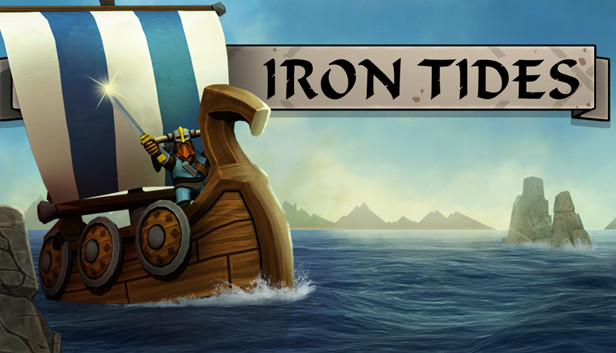An Introduction to “Iron Tides”
“Iron Tides” offers players a compelling dive into the maritime exploits of Viking warriors, blending rich historical elements with engaging gameplay mechanics. Developed by the creative minds at Crash Wave Games, “Iron Tides” integrates the harsh realities of Viking naval expeditions with the challenging aspects of roguelike strategy. This fusion results in a captivating experience where players must navigate both the perilous waters and their own tactical decisions. The historical inspiration behind the game is evident, immersing players in a setting that evokes the rugged resilience and ferocity of Viking seafarers.
The game distinguishes itself through its unique approach to combining strategy and roguelike elements. Unlike traditional strategy games that often lean towards predictable, linear progression, “Iron Tides” introduces an element of unpredictability. Each voyage presents new, randomized challenges, ensuring that no two expeditions are the same. This dynamic gameplay keeps players engaged, as they must continuously adapt their strategies to survive. Set against the backdrop of a treacherous sea, laden with mythical creatures and enemy ships, every decision can lead to triumph or disaster, echoing the real-life uncertainties faced by the Vikings.
A standout feature of “Iron Tides” is its emphasis on tactical combat and resource management. Players are tasked with commanding a Viking fleet, making critical choices about crew composition, ship upgrades, and resource allocation. This strategic depth is complemented by the game’s roguelike nature, where each decision carries significant weight and consequences. The combination of these elements fosters a sense of immersion, pulling players into the life of a Viking leader who must balance ambition with the necessity of survival.
Incorporating historically accurate elements with imaginative storytelling, “Iron Tides” offers a robust and enriching experience. Players are not merely observers but active participants in their own sagas, navigating through a world where every move is critical. With its blend of roguelike unpredictability and strategic precision, “Iron Tides” successfully captures the essence of Viking exploration and warfare, making it a notable addition to the strategy game genre.
Gameplay Mechanics and Strategy
The core gameplay mechanics of “Iron Tides” revolve around a turn-based combat system that demands both tactical finesse and strategic forethought. Players navigate through the maritime environment, where each decision carries weight. The turn-based combat is designed to challenge oversimplified gameplay, requiring players to meticulously plan their moves to outmaneuver their enemies. Each Viking warrior under the player’s command has unique abilities and roles, necessitating a considered approach to formation and attack strategies.
Resource management is another critical component of “Iron Tides,” where players must carefully allocate their resources to maintain their ship and crew. Items such as food, weapons, and trade goods are essential for survival and success on the high seas. These resources can be gathered through exploration, but they must be used judiciously to ensure the crew remains in peak fighting condition and morale is kept high. Efficient management not only influences the immediate outcomes of battles but also impacts the long-term sustainability of the voyage.
Strategic decision-making extends to ship management. The player’s vessel is more than just transportation; it is a mobile base that requires maintenance and upgrades. Customizing and upgrading the ship can provide significant advantages in combat, trade, and survival skills. Properly managing the vessel’s condition, speed, and capabilities ensures that the Vikings are always ready to face the next challenge.
“Iron Tides” employs procedural generation to enhance replayability, ensuring that no two playthroughs are identical. This dynamic generation creates diverse and challenging scenarios that keep the player engaged, constantly adapting to new situations. It is this unpredictability that enriches the tactical decision-making process, as players must continuously evolve their strategies based on the unique challenges presented.
Tactical decision-making in “Iron Tides” involves not only combat maneuvers but also long-term planning. Allocating limited resources efficiently, ensuring the morale of the crew, and strategically upgrading the ship are essential elements that shape the player’s experience. Success in “Iron Tides” is achieved through a blend of immediate tactical actions and overarching strategic goals, making every moment aboard their Viking ship a test of leadership and cunning.
Historical and Cultural Authenticity
“Iron Tides” immerses players in the historical and cultural landscape of Viking life by meticulously integrating elements of Norse mythology, seafaring culture, and warfare. The game’s developers have conducted extensive research into Viking history to ensure that the depiction of this era is both accurate and respectful, bringing the rich tapestry of the Viking world to life with remarkable fidelity.
One of the standout features of “Iron Tides” is its authentic portrayal of Viking mythology. The game incorporates legendary figures, mythical creatures, and epic sagas that are staples of Norse lore, creating a narrative that feels both epic and culturally grounded. Through characters and quests, players experience firsthand the blend of mythology and everyday life that defined the Viking Age.
The seafaring culture of the Vikings is another area where “Iron Tides” excels. The game features meticulously designed longships, employing archaeological findings and historical texts as references. These vessels, known for their sleek design and speed, were integral to Viking exploration and conquests. The game emphasizes this aspect by making seafaring a core gameplay component, allowing players to navigate the treacherous waters of the North Sea and beyond.
Warfare in “Iron Tides” is depicted with a focus on historical accuracy, highlighting the tactical prowess and ferocity of Viking warriors. The game showcases authentic weaponry, battle formations, and strategies derived from historical records. The brutal and raw nature of Viking combat is represented in a way that is both true to history and engaging for players.
To balance historical accuracy with creative freedom, the developers have taken care to infuse “Iron Tides” with elements that captivate and entertain while staying true to the Viking spirit. This thoughtful integration ensures that players are not only educated about the Viking Age but are also drawn into an immersive gaming experience that honors the source material. The result is a game that respects the past and yet feels dynamic and enthralling.
Player Reception and Community
‘Iron Tides’ has garnered a diverse range of reactions from both players and critics. As a strategic game set in a Viking era, it has captured the interest of history enthusiasts and strategy game fans alike. User reviews highlight the game’s intricate mechanics, compelling narrative, and the immersive atmosphere that transports players to the high seas. The strategic depth required has been particularly praised, allowing for nuanced exploration and combat scenarios.
Critics have acknowledged the game’s sophisticated design and thematic consistency, noting how well it encapsulates the ethos of Viking expeditions. However, some feedback pointed out areas for improvement, such as the learning curve for new players and the need for feature enhancements. These insights have been instrumental in shaping the game’s ongoing development.
The community surrounding ‘Iron Tides’ has been vibrant and engaged, contributing significantly to its evolution. Players have actively participated through forums, social media platforms, and crowdfunding sites, offering suggestions and feedback that the developers have conscientiously integrated. This community-driven approach has ensured the game remains dynamic and responsive to its audience’s needs.
One of the most notable aspects of community involvement has been through crowdfunding initiatives, which provided not just financial support but also a platform for player engagement and idea exchange. The developers of ‘Iron Tides’ have shown a commendable commitment to their player base, frequently interacting through updates and addressing concerns raised by players.
The post-launch period has seen several updates and expansions directly influenced by player feedback. These include gameplay tweaks, new content additions, and quality of life improvements that enhance the overall experience. The developers’ dedication to fostering a strong relationship with their community has played a crucial role in maintaining the game’s appeal and relevance.


No responses yet